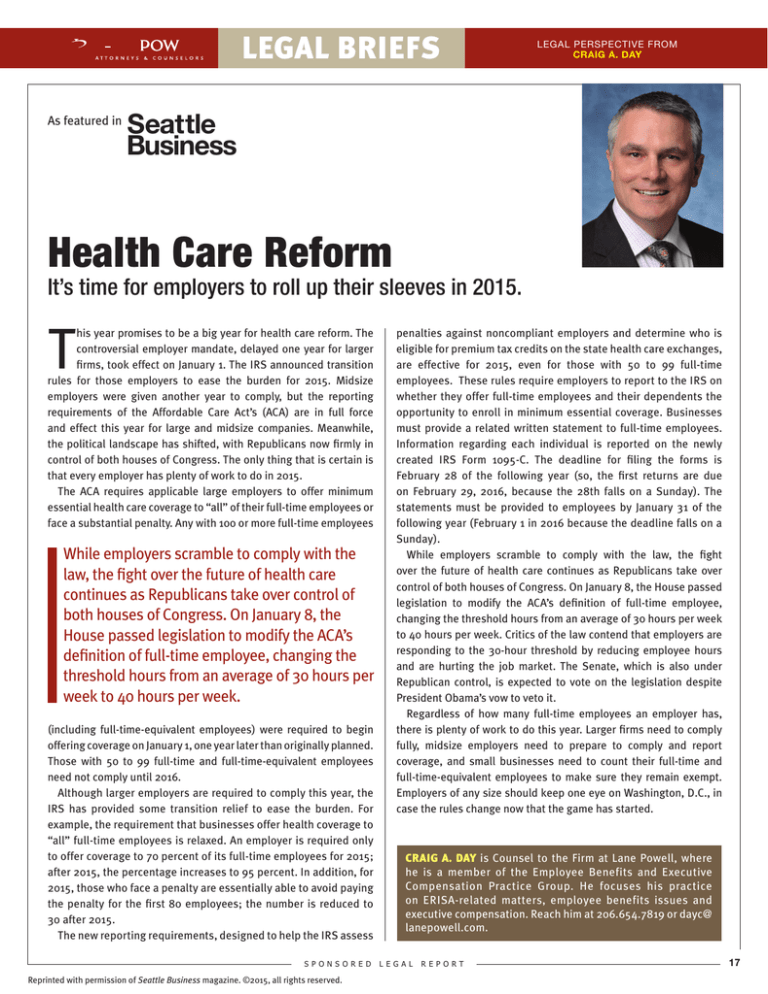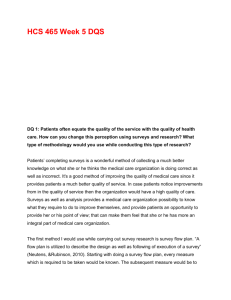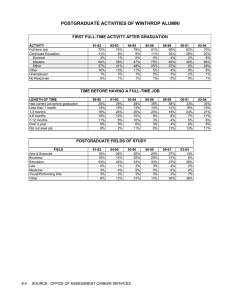T Health Care Reform LEGAL BRIEFS Seattle
advertisement

LEGAL BRIEFS As featured in LEGAL PERSPECTIVE FROM CRAIG A. DAY Seattle Business Health Care Reform It’s time for employers to roll up their sleeves in 2015. T his year promises to be a big year for health care reform. The controversial employer mandate, delayed one year for larger firms, took effect on January 1. The IRS announced transition rules for those employers to ease the burden for 2015. Midsize employers were given another year to comply, but the reporting requirements of the Affordable Care Act’s (ACA) are in full force and effect this year for large and midsize companies. Meanwhile, the political landscape has shifted, with Republicans now firmly in control of both houses of Congress. The only thing that is certain is that every employer has plenty of work to do in 2015. The ACA requires applicable large employers to offer minimum essential health care coverage to “all” of their full-time employees or face a substantial penalty. Any with 100 or more full-time employees While employers scramble to comply with the law, the fight over the future of health care continues as Republicans take over control of both houses of Congress. On January 8, the House passed legislation to modify the ACA’s definition of full-time employee, changing the threshold hours from an average of 30 hours per week to 40 hours per week. (including full-time-equivalent employees) were required to begin offering coverage on January 1, one year later than originally planned. Those with 50 to 99 full-time and full-time-equivalent employees need not comply until 2016. Although larger employers are required to comply this year, the IRS has provided some transition relief to ease the burden. For example, the requirement that businesses offer health coverage to “all” full-time employees is relaxed. An employer is required only to offer coverage to 70 percent of its full-time employees for 2015; after 2015, the percentage increases to 95 percent. In addition, for 2015, those who face a penalty are essentially able to avoid paying the penalty for the first 80 employees; the number is reduced to 30 after 2015. The new reporting requirements, designed to help the IRS assess SPONSORED Reprinted with permission of Seattle Business magazine. ©2015, all rights reserved. penalties against noncompliant employers and determine who is eligible for premium tax credits on the state health care exchanges, are effective for 2015, even for those with 50 to 99 full-time employees. These rules require employers to report to the IRS on whether they offer full-time employees and their dependents the opportunity to enroll in minimum essential coverage. Businesses must provide a related written statement to full-time employees. Information regarding each individual is reported on the newly created IRS Form 1095-C. The deadline for filing the forms is February 28 of the following year (so, the first returns are due on February 29, 2016, because the 28th falls on a Sunday). The statements must be provided to employees by January 31 of the following year (February 1 in 2016 because the deadline falls on a Sunday). While employers scramble to comply with the law, the fight over the future of health care continues as Republicans take over control of both houses of Congress. On January 8, the House passed legislation to modify the ACA’s definition of full-time employee, changing the threshold hours from an average of 30 hours per week to 40 hours per week. Critics of the law contend that employers are responding to the 30-hour threshold by reducing employee hours and are hurting the job market. The Senate, which is also under Republican control, is expected to vote on the legislation despite President Obama’s vow to veto it. Regardless of how many full-time employees an employer has, there is plenty of work to do this year. Larger firms need to comply fully, midsize employers need to prepare to comply and report coverage, and small businesses need to count their full-time and full-time-equivalent employees to make sure they remain exempt. Employers of any size should keep one eye on Washington, D.C., in case the rules change now that the game has started. CRAIG A. DAY is Counsel to the Firm at Lane Powell, where he is a member of the Employ ee Benefits and E xecutive Compensation P ractice Gr oup. He focuses his practice on E R ISA-related matters, employee benefits issues and executive compensation. Reach him at 206.654.7819 or dayc@ lanepowell.com. LEGAL REPORT 17

